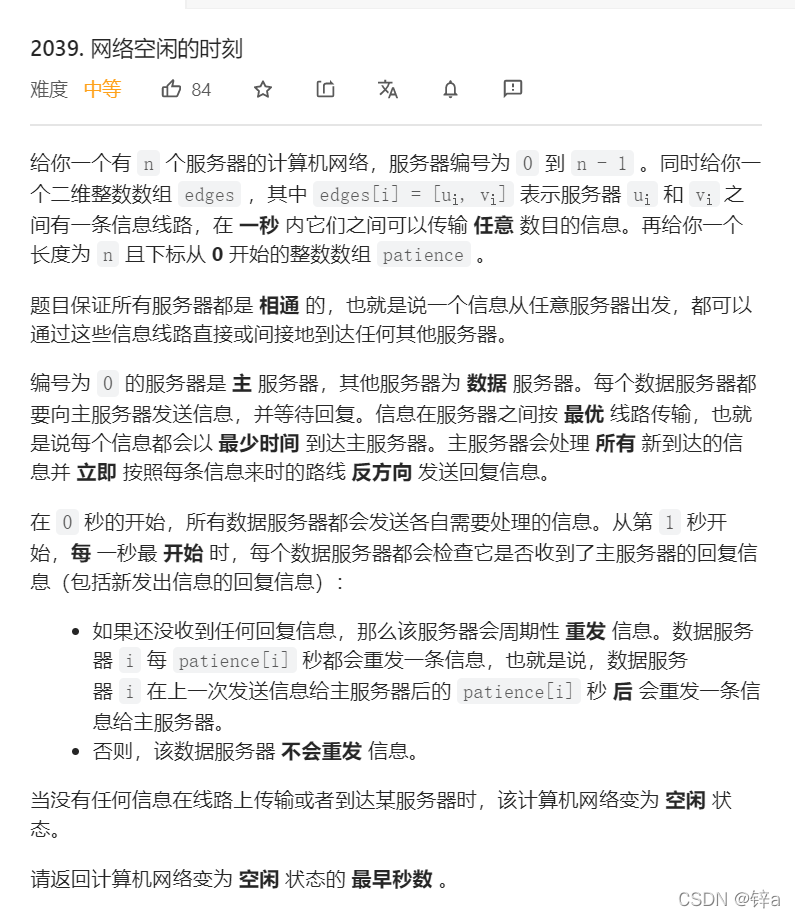楼主遇到这个问题是在LeetCode刷题时遇到2039. 网络空闲的时刻这个题目,按照BFS模板写的最后一个测试案例怎么都过不去(甚至复制官方的都过不去),幸得高人指点才发现问题所在。
题目描述:

我原始的代码为:
class Solution:
def networkBecomesIdle(self, edges: List[List[int]], patience: List[int]) -> int:
n = len(patience)
graph = [[] for _ in range(n)]
for x, y in edges:
graph[x].append(y)
graph[y].append(x)
# 广度优先遍历
queue = [0]
distance = [-1 for _ in range(n)] #得到每一个节点到0节点的最短距离
visited = [False] * n
visited[0] = True
dis_cur = 0
while queue:
size = len(queue)
for _ in range(size):
node = queue.pop(0)
distance[node] = dis_cur
for adj in graph[node]:
if visited[adj] == False:
queue.append(adj)
visited[adj] = True
dis_cur += 1
#遍历每个节点计算其变成空闲状态的最晚时间
res = 0
for i in range(1,n):
time = patience[i] * ((2*distance[i] - 1) // patience[i]) + 2 * distance[i] + 1
res = max(res,time)
return res
这里会超出时间限制的原因是:使用list.pop(0)的时间复杂度为O(n),在BFS那块达到了
O
(
n
2
)
O(n^2)
O(n2),所以在面对
1
0
5
10^5
105数据大小时会超出时间限制。
解决方法有两个:
- 使用两个list来回倒
- 使用Python库自带的双端队列
collections.deque()
需要说明的是list是一张顺序表,在使用list.pop(0)时需要使所有的元素向前平移,时间复杂度为O(n),而deque是链表,在头部插入或删除节点时间复杂度为O(1)。
先说方法一,使用两个list来回替换代替了queue.pop(0),避免了一次多余的循环:
该部分代码来自LeetCode用户Meteordream对我的评论,感谢大佬!
class Solution:
def networkBecomesIdle(self, edges: List[List[int]], patience: List[int]) -> int:
n = len(patience)
graph = [[] for _ in range(n)]
for x, y in edges:
graph[x].append(y)
graph[y].append(x)
# 广度优先遍历
queue = [0]
distance = [-1 for _ in range(n)] #得到每一个节点到0节点的最短距离
visited = [False] * n
visited[0] = True
dis_cur = 0
while queue:
# 这里用另外一个list
tmp = list()
# 不要 pop 了,直接遍历,新加入的放到新list
for node in queue:
distance[node] = dis_cur
for adj in graph[node]:
if visited[adj] == False:
tmp.append(adj)
visited[adj] = True
dis_cur += 1
# 新 list 换掉旧 queue
queue = tmp
#遍历每个节点计算其变成空闲状态的最晚时间
res = 0
for i in range(1,n):
time = patience[i] * ((2*distance[i] - 1) // patience[i]) + 2 * distance[i] + 1
res = max(res,time)
return res
方法二:
使用Python自带的双端队列方法
class Solution:
def networkBecomesIdle(self, edges: List[List[int]], patience: List[int]) -> int:
n = len(patience)
graph = [[] for _ in range(n)]
for x, y in edges:
graph[x].append(y)
graph[y].append(x)
# 广度优先遍历
queue = collections.deque() #替换为双端队列
queue.append(0)
distance = [-1 for _ in range(n)] #得到每一个节点到0节点的最短距离
visited = [False] * n
visited[0] = True
dis_cur = 0
while queue:
for _ in range(len(queue)):
node = queue.popleft()
distance[node] = dis_cur
for adj in graph[node]:
if visited[adj] == False:
queue.append(adj)
visited[adj] = True
dis_cur += 1
#遍历每个节点计算其变成空闲状态的最晚时间
res = 0
for i in range(1,n):
time = patience[i] * ((2*distance[i] - 1) // patience[i]) + 2 * distance[i] + 1
res = max(res,time)
return res